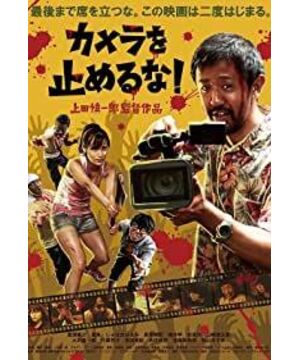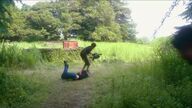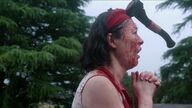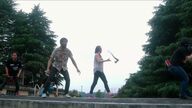"Kamela stop めるな! "The mainland translation is "The camera does not stop! ", which was translated as "Dead on the Set" when it was released in Hong Kong. I originally bought the tickets at Telford Plaza in anticipation of watching a horror zombie movie. In addition, on WMOOV, the score of the movie is as high as 9/10, so for a person who is numb and not very interested in anything, The adrenaline rush may be able to induce a little presence of life.
It has to be said that watching a movie with expectations means that your expectations may be shattered. When the plot will not develop in the expected direction, there will be countless black question marks. No matter how clichéd the preceding plot was, how rough the production was, how dizzying the camera shake was, how obtrusive the use of women's grappling as a hobby, how dubious the one-shot technique was—whether it was necessary at all , How exaggerated the "photographer" zombies are, in short, the first 30 minutes is just suspicion! Doubt! Doubt! Even if there were sporadic laughter in the theater, my sense of vigilance could not let me relax - this scene in front of me, is the real in the fiction, or the fiction in the fiction - in other words, this is the reality in front of the camera, or the camera front lens?
Since I have no way of predicting the comedy effect of the meta-narrative later, it can be said that for the first 30 minutes, I have been criticizing and dizzying - if the scene continues in the end, I will be like several others in the theater. Like an audience, leave the venue early. Yes, the biggest doubt starts from the one-shot technology. When steadicam made the photographer's lens route more flexible, more and more films began to advocate the one-shot technology - "Birdman", "Youth", "Play Tonight to Save You" all successfully used this technology model. At the same time, I have to say that one shot is completely unnecessary for most movies. After all, behind the long shot is the coincidence of the narrative time and the clock time. The slow rhythm can easily make the audience feel tired and tired. At the same time, it will also Make it obvious to the audience that the perspective in front of the camera is another person's perspective - that is, the presence of the camera cannot be ignored, and its presence means that the audience cannot suspend their doubts and let themselves believe it. Reality is right in front of you.
But it is this strange discomfort that becomes the breakthrough to enjoy the comedy.
The shaking lens seems to remind the audience of the existence of the lens itself ("Hello, this is a photographer's perspective, this photographer is not very professional, and his practice is not very good, please bear with me!"), according to Bart's photography theory , the audience is deliberately reminded that the existence of the lens means the existence of the photographer behind the lens. What's even more exaggerated is that the first 30 minutes of the movie never used a stable lens to weaken the presence of this third party. There was even a chase scene where blood was splattered on the lens. Photographer's hand wiping blood. This obvious bug is already reminding the audience that this encounter is not a real zombie (otherwise, how can you not forget to feature a zombie!). However, the improvement in the acting skills of the female pig's feet seems to imply that the heroine may not know that it is not a real zombie. In addition, when the heroine hid in the abandoned warehouse, the big white legs that were molting appeared in front of her, as if filming suddenly hit a real zombie, which makes people unable to completely abandon the sense of reality. And the director who jumps out and shouts action from time to time also makes people wonder if he is a delusional person obsessed with realistic acting skills, or an actor with comedy effects. Finally, the male and female protagonists on the rooftop relive the opening scene of the movie face to face. Due to the complete mapping structure, it seems to emphasize that this is acting.
In fact, under this blurred boundary between the real and the fictional, the audience is always in contradictory guesswork. We all know that viewers/readers often need to suspend suspicion in order to successfully empathize with a work of fiction. But at this moment, since the audience can't determine whether the scene in front of them is "real in fiction" or "another layer of fiction in fiction", the type of this scene (whether it is a thriller or a comedy) cannot be determined.
Suffice to say, without the meta-narrative that follows—about making movies, about making fictional art about fictional art—the first 30 minutes is a big bug. However, due to the revealing of the secrets in the next hour, every bug was explained satisfactorily, which reflected the fun of the first 30 minutes, and also reflected the uniqueness of the discomfort created in the first 30 minutes - this is really rare Another rare experience.
Looking back, the first 30 minutes of a scene was really not only necessary, but also shocking. At the same time, it also pushed the blurred boundary between "truth and fiction" further forward. In the end, how much of the 30-minute shot was carried out according to the original script? How many times did the situation occur on the plane and on site? Was the fall on the run a real mistake, or was it intentional? How many shots have you tried on this lens?
This shot may be a perfect imperfect dazzle after all. Its uncertainty is what makes it most fascinating.
Imagine that the script of this movie is a story about the hero and heroine who encounter zombies when shooting zombie movies under the director's emergency scene under the perfect script.
Use parentheses: { [ ( < > ) ] }
{1. The movie "Do not stop the camera! "[2. Take one shot to the end of the zombie movie "Don't stop the camera!" "(3. Zombies were encountered on the set <4. Several people in the crew were filming zombie films> )] }
Represented by the camera:
{Zhong Gengang's camera [The camera of a male cameraman with a bad waist and a novice female cameraman (the camera in the hands of "Director" Higashi Daiki)] }
Yes, the terrible thing is that the title of the movie is still the same as the title of the one shot taken by the "director" in the film (both are called One Cut of the Dead)! I am afraid that you will suddenly wake up at a certain moment whether this is true or fictional.
The postmodern meta-narrative is so fitting for Bo-jun's laughing comedy. It's all play anyway! Still very advanced!
View more about One Cut of the Dead reviews








